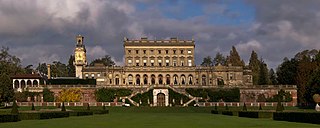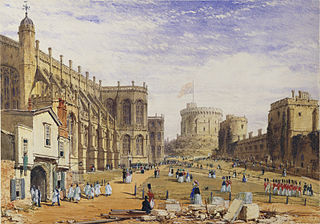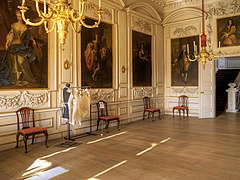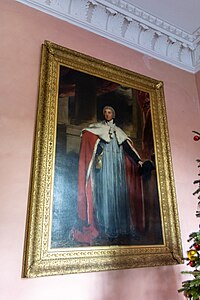
Belton House is a Grade I listed country house in the parish of Belton near Grantham in Lincolnshire, England, built between 1685 and 1687 by Sir John Brownlow, 3rd Baronet. It is surrounded by formal gardens and a series of avenues leading to follies within a larger wooded park. Belton has been described as a compilation of all that is finest of Carolean architecture, said to be the only truly vernacular style of architecture that England had produced since the Tudor period. It is considered to be a complete example of a typical English country house; the claim has even been made that Belton's principal façade was the inspiration for the modern British motorway signs which give directions to stately homes.

Edward Venables-Vernon-Harcourt was a Church of England bishop. He was the Bishop of Carlisle from 1791 to 1807 and then the Archbishop of York until his death.

Cliveden is an English country house and estate in the care of the National Trust in Buckinghamshire, on the border with Berkshire. The Italianate mansion, also known as Cliveden House, crowns an outlying ridge of the Chiltern Hills close to the South Bucks villages of Burnham and Taplow. The main house sits 40 metres (130 ft) above the banks of the River Thames, and its grounds slope down to the river. There have been three houses on this site: the first, built in 1666, burned down in 1795 and the second house (1824) was also destroyed by fire, in 1849. The present Grade I listed house was built in 1851 by the architect Charles Barry for the 2nd Duke of Sutherland.

Baron Vernon, of Kinderton in the County of Chester, is a title in the Peerage of Great Britain. It was created in 1762 for the former Member of Parliament George Venables-Vernon. He had previously represented Lichfield and Derby in the House of Commons. Born George Vernon, he was the son of Henry Vernon, of Sudbury in Derbyshire, and Anne Pigott, daughter and heiress of Thomas Pigott by his wife Mary Venables, sister and heiress of Sir Peter Venables, Baron of Kinderton in Cheshire. In 1728, he assumed by Royal Licence the additional surname of Venables upon inheriting the Venables estate in Cheshire from his childless cousin Anne, widow of the 2nd Earl of Abingdon.

Haddon Hall is an English country house on the River Wye near Bakewell, Derbyshire, a former seat of the Dukes of Rutland. It is the home of Lord Edward Manners and his family. In form a medieval manor house, it has been described as "the most complete and most interesting house of [its] period". The origins of the hall are from the 11th century, with additions at various stages between the 13th and the 17th centuries, latterly in the Tudor style.

Charlecote Park is a grand 16th-century country house, surrounded by its own deer park, on the banks of the River Avon in Charlecote near Wellesbourne, about 4 miles (6 km) east of Stratford-upon-Avon and 5.5 miles (9 km) south of Warwick in Warwickshire, England. It has been administered by the National Trust since 1946. It is a Grade I listed building and is open to the public. The park and gardens are listed Grade II* in Historic England's Register of Parks and Gardens.

Cassiobury House was a country house in Cassiobury Park, Watford, England. It was the ancestral seat of the Earls of Essex. Originally a Tudor building, dating from 1546 for Sir Richard Morrison, it was substantially remodelled in the 17th and 19th centuries and ultimately demolished in 1927. The surrounding Cassiobury Park was turned into the main public open space for Watford.

George Venables-Vernon, 1st Baron Vernon, was a British politician.

George Venables-Vernon, 2nd Baron Vernon, was the 2nd Baron Vernon of Kinderton. He acceded to the title in 1780 after the death of his father George Venables-Vernon, first Baron Vernon of Kinderton.

George Anson, known as George Adams until 1773, was a Staffordshire landowner from the Anson family and a British Whig politician who sat in the House of Commons between 1761 and 1769.

George John Warren Venables-Vernon, 5th Baron Vernon, was a British politician. He was one of the last members of parliament for Derbyshire and the first for South Derbyshire. Vernon had a lifetime enthusiasm for Italian literature, particularly Dante after visiting Italy as a child. Vernon county is named after him in Australia.

Frederick Anson (1811–1885) was a British clergyman from the Anson family, who served as Canon of St George's Chapel, Windsor Castle.
The Vernon family was a wealthy, prolific and widespread English family with 11th-century origins in Vernon, Normandy, France. Their extant titles include Baron Vernon and Vernon baronets of Shotwick Park.

Fairfax House is a Georgian townhouse located at No. 27, Castlegate, York, England, near Clifford's Tower and York Castle Museum. It was probably built in the early 1740s for a local merchant and in 1759 it was purchased by Charles Gregory Fairfax, 9th Viscount Fairfax of Emley, who arranged for the interior to be remodelled by John Carr (architect). Fairfax was the widower of heiress Elizabeth Clifford, daughter of Hugh Clifford, 2nd Baron Clifford of Chudleigh: his inheritance from her death enabled him to purchase the house, which he intended as a home for his daughter from his first marriage, Ann Fairfax.

George Webster was a 19th-century British Marine Art painter. He toured extensively and painted seascapes of the places he visited. His work was exhibited at the Royal Society of British Artists and the Royal Academy.
Commander Francis Lawrance William Venables-Vernon, 9th Baron Vernon DL, styled The Honourable Francis Venables-Vernon from 1889 to 1915, was a British soldier.

Frances Margaret Venables-Vernon, Baroness Vernon was an American heiress who married into the British aristocracy.

Augustus Henry Venables-Vernon, 6th Baron Vernon, was a British landowner and soldier.
Sir Thomas Vernon was a London merchant and director of the East India Company who served in the Parliament of England.
Henry Vernon, of Sudbury, Derbyshire, was an English landowner and politician.
































